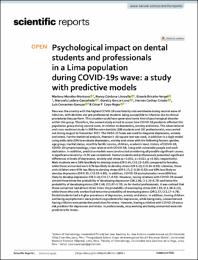Mostrar el registro sencillo del ítem
Psychological impact on dental students and professionals in a Lima population during COVID-19s wave: a study with predictive models
| dc.contributor.author | Cayo Rojas, César Félix | |
| dc.contributor.author | Morales‑Montoya, Mariana | |
| dc.contributor.author | Córdova‑Limaylla, Nancy | |
| dc.contributor.author | Briceño‑Vergel, Gissela | |
| dc.contributor.author | Ladera‑Castañeda, Marysela | |
| dc.contributor.author | Garcia‑Luna, Goretty | |
| dc.contributor.author | Cachay‑Criado, Hernán | |
| dc.contributor.author | Cervantes‑Ganoza, Luis | |
| dc.date.accessioned | 2022-11-03T17:30:20Z | |
| dc.date.available | 2022-11-03T17:30:20Z | |
| dc.date.issued | 2022 | |
| dc.identifier.uri | https://hdl.handle.net/20.500.14308/4117 | |
| dc.description.abstract | Peru was the country with the highest COVID-19 case fatality rate worldwide during second wave of infection, with dentists and pre-professional students being susceptible to infection due to clinical procedures they perform. This situation could have generated some kind of psychological disorder within this group. Therefore, the present study aimed to assess how COVID-19 pandemic afected this population group during second wave, in relation to depression, anxiety and stress. This observational and cross-sectional study in 368 Peruvian dentists (186 students and 182 professionals), was carried out during August to November 2021. The DASS-21 Scale was used to diagnose depression, anxiety and stress. For the statistical analysis, Pearson’s chi-square test was used, in addition to a logit model using odds ratio (OR) to evaluate depression, anxiety and stress with the following factors: gender, age group, marital status, monthly family income, children, academic level, history of COVID-19, COVID-19 symptomatology, close relative with COVID-19, living with vulnerable people and work dedication. In addition, predictive models were constructed considering all possible signifcant causes. A signifcance level of p< 0.05 was considered. Dental students and professionals presented signifcant diferences in levels of depression, anxiety and stress (p< 0.001, p= 0.022, p= 0.001; respectively). Male students were 56% less likely to develop stress (OR 0.44; CI 0.22–0.85) compared to females; while those unmarried were 81% less likely to develop stress (OR 0.19; CI 0.04–0.85). Likewise, those with children were 83% less likely to develop stress (OR 0.17; CI 0.06–0.52) and 65% less likely to develop depression (OR 0.35; CI 0.15–0.80). In addition, COVID-19 asymptomatics were 60% less likely to develop depression (OR 0.40; CI 0.17–0.92). However, having relatives with COVID-19 caused almost three times the probability of developing depression (OR 2.96; CI 1.29–6.79) and twice the probability of developing stress (OR 2.49; CI 1.07–5.78). As for dental professionals, it was noticed that those unmarried had almost three times the probability of developing stress (OR 2.93; CI 1.38–6.23); while those who only worked had twice the probability of developing stress (OR 2.37; CI 1.17–4.78). Dental students had a higher prevalence of depression, anxiety and stress. In addition, having children and being asymptomatic were protective predictors for depression, while being male, unmarried and having children were protective predictors for stress. However, having a relative with COVID-19 was a risk predictor for depression and stress. In professionals, only working and being unmarried were risk predictors for stress. | es_PE |
| dc.format | application/pdf | es_PE |
| dc.language.iso | en | es_PE |
| dc.publisher | Scientific Reports | es_PE |
| dc.rights | info:eu-repo/semantics/openAccess | es_PE |
| dc.rights | Attribution-NonCommercial-NoDerivs 3.0 United States | * |
| dc.rights.uri | http://creativecommons.org/licenses/by-nc-nd/3.0/us/ | * |
| dc.source | Universidad Privada San Juan Bautista | es_PE |
| dc.source | Repositorio institucional - UPSJB | es_PE |
| dc.subject | Impacto psicológico | es_PE |
| dc.subject | Estudiantes y profesionales de odontología | es_PE |
| dc.subject | Población limeña | es_PE |
| dc.subject | COVID-19 | es_PE |
| dc.title | Psychological impact on dental students and professionals in a Lima population during COVID-19s wave: a study with predictive models | es_PE |
| dc.type | info:eu-repo/semantics/article | es_PE |
| dc.subject.ocde | https://purl.org/pe-repo/ocde/ford#3.02.14 | es_PE |
| dc.publisher.country | GB | es_PE |
| dc.date.embargoEnd | 2022-11-03 | |
| dc.identifier.doi | https://doi.org/10.1038/s41598-022-18899-x | es_PE |
| dc.type.version | info:eu-repo/semantics/publishedVersion | es_PE |
| upsjb.especialidad | Estomatología | es_PE |



